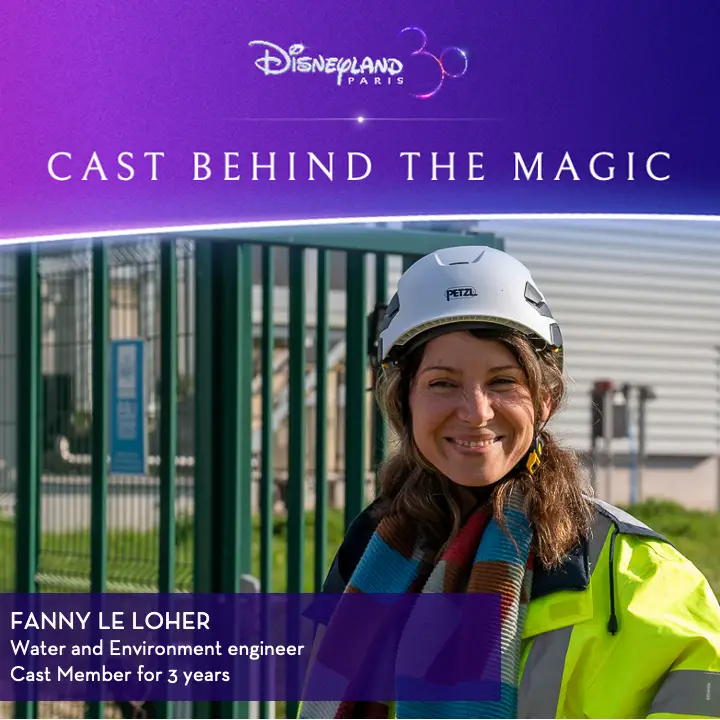There are many different cast members that bring Disneyland Paris to life. They have many different roles and contributions. Disneyland Paris has been introducing some of them to the world. Today, Disneyland Paris shared an interview with Fanny Le Loher, a Water and Environment Engineer at Disneyland Paris. Read about Fanny in the interview below!

Tell us about your job. What’s it all about?
I’m a Water and Environment Engineer. It’s a very broad role that covers a multitude of tasks, but at Disneyland Paris, my job is to manage the wastewater treatment plant (WWTP) and manage the use of treated wastewater in line with laws and regulations. The job also involves regular communication with the public authorities. Although the reuse of treated wastewater is increasingly regulated, it’s still not very widespread in France. At Disneyland Paris, however, we have been lucky enough to have this water installation and recycling system for ten years!
Occasionally, I’m also asked to provide my expertise on topics relating to water management.

What’s your academic background? Why did you apply to Disneyland Paris?
To become a water and environment engineer, I obtained an engineering degree from the National School of Water and Environmental Engineering in Strasbourg. I also have a master’s degree in environmental engineering and sciences, which I passed at the same time, at the University of Strasbourg.
I had the opportunity to apply to Disneyland Paris 3 years ago, through my alumni network. One of my former colleagues, herself a Cast Member, posted the job offer on the network. I was immediately taken by the company’s environmental policy.
Which team do you work in? What are the main challenges you face when it comes to water conservation?
I’m part of a team of around ten Cast Members — the Energy and Environment Department, whose goal is to reduce the environmental footprint of the whole destination. To do this, we monitor the consumption of resources — in particular water and energy. At the same time, we also work on projects designed to enhance our environmental performance.
I’m the team member responsible for water, while I am also a training manager, assisting an apprentice who works alongside me on my various projects.
Do you work in conjunction with other teams? Does that pose any challenges?
We work in close collaboration with the Environment team, who draw up our water strategy, and support and guide us in our various projects. I also work in collaboration with all the teams at the destination who consume treated wastewater – the teams in charge of operating the attractions, the horticulture teams and maintenance personnel – to oversee the use of treated wastewater and ensure responsible consumption. The difficulty when working with the many teams at the destination is that we have to adapt to each person’s specific needs. It’s essential that the guest experience isn’t affected, so we need to work closely with everyone to learn their team’s objectives and work with them accordingly.

What does a typical day look like for you?
My days are never really the same, as my duties are very varied and there’s always something you can’t plan for. But certain tasks I do carry out every day, for example making sure the treatment plant is working properly, checking that the water is correctly distributed across the destination and most importantly, that there are no leaks. I also work with the Cast Members in my team on current and future projects, to accelerate the site’s ecological transition.
What’s special about your job at Disneyland Paris?
Working at Disneyland Paris is a special experience in itself — you get to experience the magic every day, while also progressing your career at an exceptional destination. But in technical terms, the great thing about working at the Disneyland Paris treatment plant is that the destination produces and uses its own water. In other words, the destination produces wastewater from the parks and backstage areas and then purifies and reuses it for things like road cleaning or watering plants. Outside Disneyland Paris, often several different entities involved. But in our case, the cycle runs more smoothly because we have full visibility of the production and reuse of our treated waste water.
The second great thing is the company’s strong environmental policy and the resources used to implement it. Disneyland Paris has a number of environmental programmes in place and is committed to always looking further ahead, which allows us to work with the many resources at our disposal.

This summer season, water is a very precious resource. How do you work to preserve it?
The WWTP is Disney’s leading asset when it comes to preserving the water resource. Reusing treated wastewater allows us to save more than 300,000 m3 of water per year, particularly in summertime when it’s needed for irrigation and filling pools and ponds.
One of our greatest challenges is to prevent water leaks and wastage, which is a daily task for several of our teams. We are developing digital services that will give us a centralised, remote and real-time view of how water is used at various points at the destination.
In addition, we are conducting a study to find solutions to promote the better use of water and to harvest unconventional water resources, which means any source other than the public drinking water network, such as rainwater or groundwater. The use of unconventional water sources will allow us to be even more virtuous and resilient in countering the impact of drought in future.


What do you think of Fanny and her role at Disneyland Paris? Did you learn anything from her interview? What did you find the most interesting? Share your thoughts, opinions, and take-aways in the comments below!






